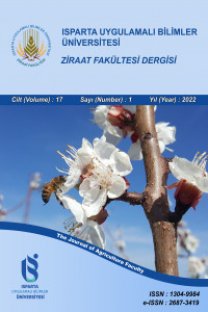The Effect of Biochar Obtained From Pruning Residue of Oil-Bearing Rose on Flower Yield and Essential Oil Content of Oil-Bearing Rose
Rosa damascena, biochar, flower yield, essential oil content
The Effect of Biochar Obtained From Pruning Residue of Oil-Bearing Rose on Flower Yield and Essential Oil Content of Oil-Bearing Rose
___
- Anonymous 2004. Sebzecilik 2. Tarim ve Koy Işleri Bakanligi Yaygin Ciftci Egitim Projesi.
- Baydar, 2015. Yag Gulu Tarimi ve Endustrisi Prof. Dr. Hasan BAYDAR Suleyman Demirel Universitesi Ziraat Fakultesi Tarla Bitkileri Bolumu, pp. 1-4.
- Boyle, S., Ardill, J., 1989. The Greenhouse Effect: A Partical Guide to the World's Changing Climate, London:Hodder and Stoughton.
- Castaldi, S., Riondino, M., Baronti, S., Esposito, F.R., Marzaioli, R., Rutigliano, F.A., Vaccari, F.P., Miglietta, F., 2011. Impact of biochar application to a Mediterranean wheat crop on soil microbial activity and greenhouse gas fluxes. Chemosphere 85:1464-1471.
- Chan, K. Y., Xu, Z., 2010. Biochar: Nutrient Properties and Their Enhancement. In: J. Lehmann & S. Joseph (Eds) Biochar for environmental management: science and technology. pp:67-84. London Earthscan. ISBN:184407658X/9781844076581.
- Demirbas, A., Karakoy, T., Durukan, H., Erdem, H., 2017. The Impacts of the Biochar Addition in Different Doses on Yield and Nutrient Uptake of the Chickpea Plant (Cicer Arietinum L.) under the Conditions With and Without Incubation. Fresenius Environmental Bulletin, 26(12A) pp. 8328-8336.
- Ding, Y., Liu, Y.X., Wu, W.X., Shi, D.Z., Yang, M., Zhong, Z.K., 2010. Evaluation of biochar effects on nitrogen retention and leaching in multi-layered soil columns. Water Air Soil Pollution. 213:47-55.
- Erbas, S., Baydar, H., 2016. Variation in scent compounds of oil-bearing rose (Rosa damascena Mill.) produced by headspace solid phase microextraction, hydrodistillation and solvent extraction. Records of Natural Products, 10 (5): 555-565.
- Glaser, B., Lehmann, J. & Zech, W. 2002. Ameliorating physical and chemical properties of highly weathered soils in the tropics with charcoal – a review. Biology and Fertility of Soils, 35, 219–230.
- Laird, D., Fleming, P., Wang, B., Horton, R., Karlen, D., 2010. Biochar impact on nutrient leaching from a Midwestern agricultural soil. Geoderma. 158:436-442.
- Lehmann, J., Rillig, M.C., Thies, J., Masiello, A.C., Hockaday, W. C., Crowley, D., 2010. Biochar effects on soil biota-A review. Soil Biology & Biochemistry 43:1812-1836.
- Liang, B., Lehmann, J. & Solomon, D. 2006. Black carbon increases cation exchange capacity in soils. Soil Science Society of America
- Luo, Y., Durenkamp, M., DeNobili, M., Lin, Q., Brookes, P.C., 2011. Short term soil priming effects and mineralisation of Biochar following its incorporation to soils of different pH. Soil Bology & Biochemistry. 43:2304-2314.
- Prendergast-Miller, M.T., Duvall, M., Sohi, S.P., 2011. Localization of nitrate in the rhizosphere of Biochar-amanded soil. Soil Biology & Biochemistry. 43:2243-2246
- Schmidt, M.W.I. & Noack, A.G. 2000. Black carbon in soils and sediments: analysis, distribution, implications, and current challenges. Global Biogeochemical Cycles, 14, 777–793.
- Sohi, S., Krull, E., Lopez-Capel, E., Bol, R., 2010. A review of biochar and its use and function in soil. Advances in Agronomy. 105:47-82.
- Yanai, Y., Toyota, K., Okazaki, M., 2007. Effects of charcoal addition on N2O emissions from soil resulting from rewetting air-dried soil in short-term laboratory experiments. Soil Science & Plant Nutrition. 53:181-188.
- Zavollini, C., Alberti, G., Biasiol, S., Vedove, G.D., Fornasier, F., Liu, J., Peressotti, A., 2011. Microbial mineralization of biochar and wheat straw mixture in soil: A short term study. Applied Soil Ecology. 50:45-51.
- ISSN: 1304-9984
- Yayın Aralığı: Yılda 2 Sayı
- Başlangıç: 2006
- Yayıncı: Isparta Uygulamalı Bilimler Üniversitesi
Siirt Yöresi Fıstık Üreticilerinin Sulama Egilimlerinin Belirlenmesi
Zafer Ali SERBEŞ, Umut OKKAN, Şerafettin AŞIK
Usability of Shallow Groundwater in Irrigated Agriculture: A Case Study From Turkey
Sultan KIYMAZ, Ufuk KARADAVUT, Galip ŞİMŞEK, Kübra SOĞANCI
Farklı Bor Konsantrasyonlarının Ekmeklik Buğday Çeşitlerinin Çimlenmesi Üzerine Etkileri
Ezgi KURTULMUŞ, Hayrettin KUŞÇU, Bilge ARSLAN, İpek KARAKUŞ, Emir KUMRALTEKİN, İdil Eylül UÇAN, Mehmet Can AŞIK
Naciye Aygen ÖZHAN, Kenan BÜYÜKTAŞ, Ahmet TEZCAN
Arazi Toplulaştırma Projelerinde Yol Uzunluklarının Analizi: Şanlıurfa Türkeli Köyü Örneği
Hamza KUZU, Fırat ARSLAN, Hasan DEĞİRMENCİ
Sakarya İli Taraklı İlçesi Sulama Suyu Kaynaklarının Su Kalitesinin Belirlenmesi
